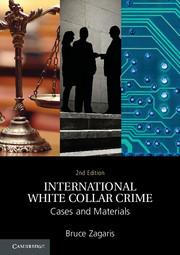Book contents
- Frontmatter
- Contents
- Preface
- 1 Introduction
- 2 Taxation
- 3 Money Laundering and Counterterrrorism Financial Enforcement
- 4 Transnational Corruption
- 5 Transnational Organized Crime
- 6 Export Control and Economic Sanctions
- 7 International Environmental Crimes
- 8 International Securities Enforcement
- 9 Extraterritorial Jurisdiction
- 10 International Evidence Gathering
- 11 Extradition and Alternatives
- 12 International Prisoner Transfer
- 13 The United Nations
- 14 The World Bank Group
- 15 INTERPOL
- 16 Economic Integration and Business Crimes
- Index
- References
6 - Export Control and Economic Sanctions
Published online by Cambridge University Press: 05 November 2015
- Frontmatter
- Contents
- Preface
- 1 Introduction
- 2 Taxation
- 3 Money Laundering and Counterterrrorism Financial Enforcement
- 4 Transnational Corruption
- 5 Transnational Organized Crime
- 6 Export Control and Economic Sanctions
- 7 International Environmental Crimes
- 8 International Securities Enforcement
- 9 Extraterritorial Jurisdiction
- 10 International Evidence Gathering
- 11 Extradition and Alternatives
- 12 International Prisoner Transfer
- 13 The United Nations
- 14 The World Bank Group
- 15 INTERPOL
- 16 Economic Integration and Business Crimes
- Index
- References
Summary
Introduction
Export controls and related rules and restrictions, especially those imposed by the United States, create a “frightful labyrinth” for practitioners. In the United States, several agencies issue regulations and licenses to control exports based on different statutes. These regulations then interact with numerous free-standing pieces of legislation, many of which are not enacted as amendments to basic statutes or codified. As a result, it can be hard to find and understand the various applicable laws. In addition, the objectivity and transparency one finds in other regulatory areas are often missing from the export control area. Finally, practitioners working in the export control field often find that limitations on judicial review and judicial deference to the executive branch on matters related to foreign policy or national security result in relatively little oversight of official actions.
Economic sanctions are even broader than export controls, encompassing the imposition by governmental or international organizations of economic sanctions for noneconomic foreign policy reasons. Examples include a variety of trade and investment sanctions against apartheid-era South Africa; financial and other sanctions against Panama; measures against Libya, especially after the bombing of Pan Am Flight 103; UN sanctions against Sudanese leaders and against former Liberian head of state Charles Taylor; U.S. sanctions targeting narcotics traffickers and kingpins; and U.S. and international sanctions against persons engaged in transnational terrorism.
Sanctioning parties have three possible mechanisms by which to inflict costs on targeted countries: limiting exports, restricting imports, and impeding finances, including reducing aid. Trade sanctions involve costs to the target country in terms of lost export markets, denial of critical imports, lower prices for embargoed exports, and higher domestic prices for substitute imports. In cases where only export or import controls have been invoked, the targeting countries generally prefer export controls to restrictions on imports.
- Type
- Chapter
- Information
- International White Collar CrimeCases and Materials, pp. 212 - 251Publisher: Cambridge University PressPrint publication year: 2015
References
- 1
- Cited by



